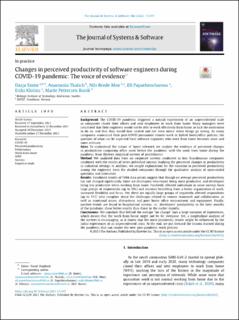| dc.contributor.author | Smite, Darja | |
| dc.contributor.author | Tkalich, Anastasiia | |
| dc.contributor.author | Moe, Nils Brede | |
| dc.contributor.author | Papatheocharous, Efi | |
| dc.contributor.author | Klotins, Eriks | |
| dc.contributor.author | Buvik, Marte Pettersen | |
| dc.date.accessioned | 2022-04-29T08:29:24Z | |
| dc.date.available | 2022-04-29T08:29:24Z | |
| dc.date.created | 2022-01-13T13:52:37Z | |
| dc.date.issued | 2022 | |
| dc.identifier.citation | Journal of Systems and Software. 2022, 186 (111197). | en_US |
| dc.identifier.issn | 0164-1212 | |
| dc.identifier.uri | https://hdl.handle.net/11250/2993341 | |
| dc.description.abstract | Background:
The COVID-19 pandemic triggered a natural experiment of an unprecedented scale as companies closed their offices and sent employees to work from home. Many managers were concerned that their engineers would not be able to work effectively from home, or lack the motivation to do so, and that they would lose control and not even notice when things go wrong. As many companies announced their post-COVID permanent remote-work or hybrid home/office policies, the question of what can be expected from software engineers who work from home becomes more and more relevant.
Aims:
To understand the nature of home telework we analyze the evidence of perceived changes in productivity comparing office work before the pandemic with the work from home during the pandemic from thirteen empirical surveys of practitioners.
Method:
We analyzed data from six corporate surveys conducted in four Scandinavian companies combined with the results of seven published surveys studying the perceived changes in productivity in industrial settings. In addition, we sought explanations for the variation in perceived productivity among the engineers from the studied companies through the qualitative analysis of open-ended questions and interviews.
Results:
Combined results of 7686 data points suggest that though on average perceived productivity has not changed significantly, there are developers who report being more productive, and developers being less productive when working from home. Positively affected individuals in some surveys form large groups of respondents (up to 50%) and mention benefiting from a better organization of work, increased flexibility and focus. Yet, there are equally large groups of negatively affected respondents (up to 51%) who complain about the challenges related to remote teamwork and collaboration, as well as emotional issues, distractions and poor home office environment and equipment. Finally, positive trends are found in longitudinal surveys, i.e., developers’ productivity in the later months of the pandemic show better results than those in the earlier months.
Conclusions:
We conclude that behind the average “no change” lays a large variation of experiences, which means that the work from home might not be for everyone. Yet, a longitudinal analysis of the surveys is encouraging, as it shows that the more pessimistic results might be influenced by the initial experiences of an unprecedented crisis. At the end, we put forward the lessons learned during the pandemic that can inspire the new post-pandemic work policies. | en_US |
| dc.language.iso | eng | en_US |
| dc.publisher | Elsevier | en_US |
| dc.rights | Navngivelse 4.0 Internasjonal | * |
| dc.rights.uri | http://creativecommons.org/licenses/by/4.0/deed.no | * |
| dc.subject | COVID-19 | en_US |
| dc.subject | Perceived productivity | en_US |
| dc.subject | Performance | en_US |
| dc.subject | Work-from-home | en_US |
| dc.subject | WFH | en_US |
| dc.subject | Surveys | en_US |
| dc.subject | Empirical study | en_US |
| dc.title | Changes in perceived productivity of software engineers during COVID-19 pandemic: The voice of evidence | en_US |
| dc.title.alternative | Changes in perceived productivity of software engineers during COVID-19 pandemic: The voice of evidence | en_US |
| dc.type | Peer reviewed | en_US |
| dc.type | Journal article | en_US |
| dc.description.version | publishedVersion | en_US |
| dc.rights.holder | © 2021 The Authors | en_US |
| dc.source.pagenumber | 14 | en_US |
| dc.source.volume | 186 | en_US |
| dc.source.journal | Journal of Systems and Software | en_US |
| dc.identifier.doi | 10.1016/j.jss.2021.111197 | |
| dc.identifier.cristin | 1980492 | |
| dc.relation.project | Norges forskningsråd: 309344 | en_US |
| dc.relation.project | Norges forskningsråd: 267704 | en_US |
| dc.source.articlenumber | 111197 | en_US |
| cristin.ispublished | true | |
| cristin.fulltext | original | |
| cristin.qualitycode | 2 | |

